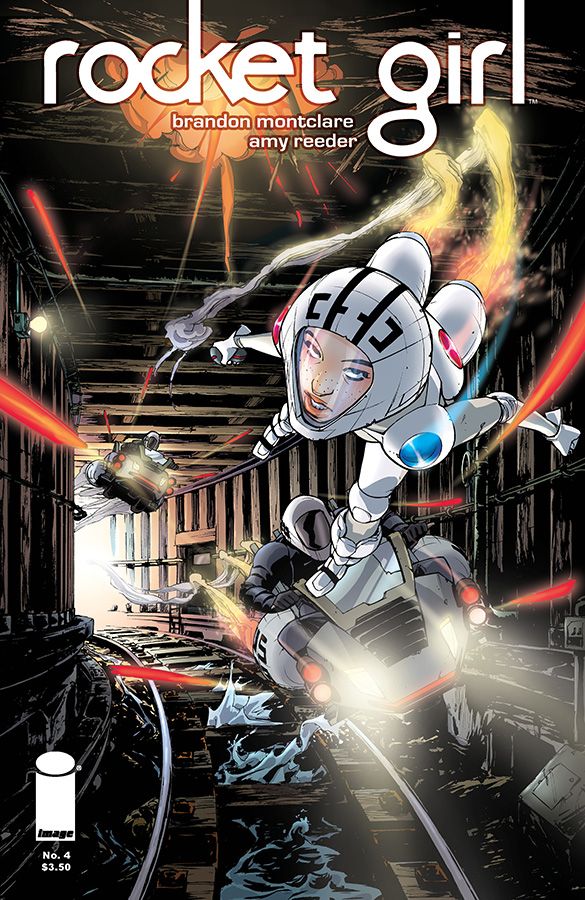In "Rocket Girl" #4 by Brandon Montclare and Amy Reeder, DaYoung Johansson in 1983 struggles to evade Quintim goons, while one of her co-workers back in 2013 questions why the NYPTD is fighting Quintim at all.
With the exception of a flashback sequence set in 2013, all of "Rocket Girl" #4 is an extended chase scene, pushing the bulk of storytelling into the artist's court. Unsurprisingly, Reeder is excellent with this type of action, and she gets ample room for visual play. Reeder's camera angles come in from all directions and she sets herself challenges with foreshortening and panel layouts. She succeeds in making the action more exciting while still keeping it easy to follow.
"Rocket Girl" #4 will be especially enjoyable for those who like the Big Apple. The backgrounds are rich with bystanders and architecture details, and the ending scene set in Grand Central station is beautiful. The arc of DaYoung's flight across the bank of windows does justice to the space. Reeder's color work adds to these effects, and the peach-red she favors for the jet engines and their golden vapor trails are especially striking. Her character design continues to be great as well, with each character having a distinctive look and a wide variety of body types and features among the cast.
"Rocket Girl" #4 is long on action, and while this action is visually enjoyable to follow, it falls short on plot developments of any substance. Montclare drops hints that there are deeper machinations in Quintim Mechanics when the men sent after DaYoung arguing about whether or not their pursuit of her will put a wrench in the "master plan," but the reader doesn't know much more than DaYoung.
It's a problem that the story is moving so slowly on disclosure, and it's also slowing down the character development. On the first page of the debut issue, Montclare set up the Who, What, When and Where of DaYoung's leap into the past, but not the Why. Four issues in, readers haven't learned much more about DaYoung's mission and her motive for risking so much to travel back in time to 1983.
Montclare's dialogue also loses some of its sharpness, and it is especially stale in the scene between the 1983 Quintim scientists. The characters spout trite melodramatic lines like "we can't do this!" and "now it's up to us - and only us - to make everything right" without noticeable irony. However, the NYPD scenes still provide fun comic relief, and the ending cliffhanger is thrilling just for the adrenaline rush of the Reeder's half-page panels. She really captures the holding-one's-breath sense of falling.
It's a pleasure that Montclare largely hasn't been recycling time travel genre stereotypes, but while he's avoided imitation, his plot is noticeably losing steam. Reeder's art still makes "Rocket Girl" #4 worth reading, and one hopes that future issues will revive Montclare's flare for snappy diction and rev up the pace of plot developments.

